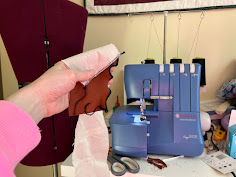Should You Buy a Serger?
If you're an avid sewist or just starting your journey into garment making, you may have heard about sergers. These specialized sewing machines, also known as overlock machines, are fantastic for finishing seams, creating professional-looking hems, and working with stretchy fabrics. But is investing in a serger the right move for you? Let's explore the pros and cons to help you decide.
Pros of Buying a Serger
1. Professional Finish
A serger trims the seam allowance and encloses the raw edges with thread, preventing fraying and giving your projects a polished, store-bought appearance. This is particularly beneficial for garments and home décor items that require a neat finish.
2. Speed and Efficiency
Sergers sew much faster than regular sewing machines. With their ability to stitch, trim, and finish edges in one go, they can significantly cut down the time spent on projects, making them a great asset for those who sew frequently.
3. Ideal for Stretchy and Knit Fabrics
If you love working with knits, a serger is a game-changer. Unlike a standard sewing machine, which can struggle with stretchy materials, a serger creates flexible seams that move with the fabric, preventing breakage and puckering.
4. Strong and Durable Seams
A serger’s multi-thread stitch makes seams stronger and more resilient than those created with a regular sewing machine. This is especially useful for activewear, swimwear, and children’s clothing that needs to withstand frequent washing and wear.
5. Rolled Hem and Decorative Stitching Options
Sergers can do more than just overlock stitches. Many models offer rolled hem functions for delicate finishes on lightweight fabrics like chiffon and silk, as well as decorative edges that add creative flair to projects.
Cons of Buying a Serger
1. Cost
A serger is an investment. Even basic models can be expensive, typically starting around $200, while higher-end models can go well over $1,000. If you’re on a tight budget, you may want to evaluate whether the benefits justify the expense.
2. Learning Curve
Sergers are more complex than regular sewing machines, requiring practice to thread properly and adjust tension settings for different fabrics. Many beginners find threading intimidating, as most models use multiple spools of thread and intricate pathways.
3. Not a Replacement for a Sewing Machine
A serger cannot replace a traditional sewing machine. It cannot sew buttonholes, zippers, or perform basic straight stitches needed for many sewing projects. If you're looking for an all-in-one machine, a serger alone won’t be sufficient.
4. Additional Maintenance and Thread Costs
Sergers require frequent maintenance, including cleaning out lint buildup and oiling the machine. Additionally, they use multiple spools of thread simultaneously, which means you’ll need to stock up on thread more frequently than with a regular sewing machine.
Should You Buy a Serger?
A serger is a great addition to any sewing setup if you work with stretchy fabrics, want a professional finish, and value efficiency. However, the cost and learning curve may make it a daunting purchase for beginners. If you're unsure, consider starting with a basic model or borrowing one before making the investment.
Do you own a serger? What’s your experience been like? Share your thoughts in the comments! Be sure to check out my Amazon Storefront for fun sewing supplies! Note: I make a small commission when you purchase something through my link. Thank you for the support :)









Comments
Post a Comment